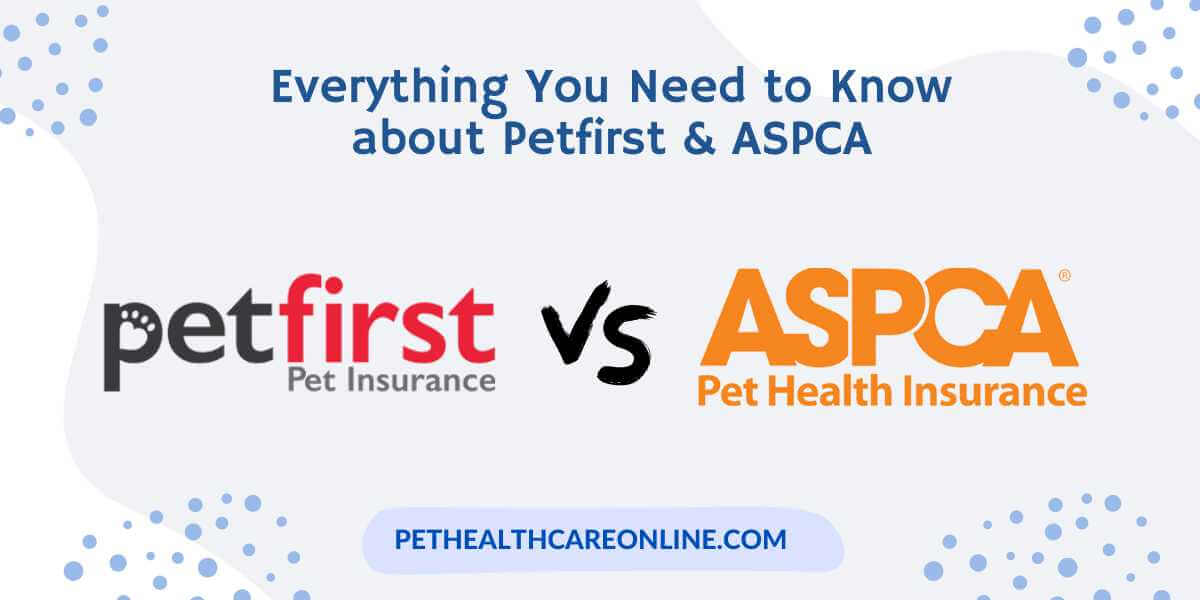In order to provide our pets with the best quality of life, we need to do more than just love them and keep them active. Unfortunately, many pets can become subjects to various injuries, accidents, and illnesses throughout their lifetime.
ASPCA allows you to visit any veterinary clinic in the United States.
When such an issue occurs, the treatment bill can be quite high. This is exactly why pet parents ought to think about getting suitable pet insurance. Be it for diagnostics, regular doctor checkups, pet illnesses management, or a dental procedure, the right pet health insurance can tend to your pet’s every need. Budget-friendly and reliable, there are many pet insurance companies that can meet you halfway, including PetFirst and ASPCA.
Both leaders on the pet insurance market here is a full comparison of PetFirst vs ASPCA to help you choose a more adequate provider for you.
Comparing PetFirst vs ASPCA Pet Insurance
Founded in 2004, PetFirst has made a name as an affordable and stable pet insurance company, whose customers always have a safe financial cushion to rely on.
Purchased by the MetLife Insurance Group in 2020, PetFirst Pet Insurance is also known as a company that regularly collaborates with local shelters, promoting the adoption of homeless animals. This, alongside their designated pet insurance plans, has earned PetFirst a BBB (Better Business Bureau) an A+ rating.
ASPCA, on the other hand, short for American Society for the Prevention of Cruelty to Animals, is an eponymous organization, first founded back in 1866. Ever since 2006, when the ASPCA Pet Insurance branch was established, the provider has partnered with the Crum & Forster Pet Insurance Group, one of the best-known pet insurance companies in the entire USA. With a massive reputation to uphold, ASPCA’s pet insurance cover offers a wide variety of flexible insurance plans to their customers.
Having said that, each plan offered by both PetFirst and ASPCA will depend on various particular circumstances. Such include the state you reside in, your pet’s species, breed, gender, and age, as well as your budgetary allowances. Although similar in their offerings, here is how PetFirst and ASPCA differ and what each of their services includes.
PetFirst Coverage Options
As part of their pet insurance plans, PetFirst offers coverage options for everything your pet might need, except for pet pre-existing conditions, breeding-related expenses (including spaying and neutering), cosmetic, experimental, and elective procedures (like ear clippings, for example). Furthermore, depending on your state, PetFirst may or may not cover dental health expenses.
PetFirst covers the following pet necessities: illnesses, accident-sustained injuries, broken bones, heart problems, blood pressure issues, cancer treatments, emergency hospitalizations, X-rays, surgeries, diagnostics, blood tests, holistic and alternative therapy (like acupuncture), chronic, congenital, and hereditary issues, diabetes, and medications.
Bear in mind that pet parents will have to go through a 6-month waiting period to get approval for cruciate ligament pet issues – anterior, posterior, and cranial problems – in addition to IVDD.
With an additional pet wellness coverage and routine care pack, you can even get coverage for vaccinations, vet exam fees, and preventative care expenses.
Other than that, PetFirst offers three coverage plans – The Cost Conscious Plan ($2,000 annual cap), The Recommended or Most Popular Plan ($5,000 annual cap), and The Advanced Plan ($10,000 annual cap).
ASPCA Coverage Details
ASPCA, too, has more than one type of coverage that they offer for pets, although these exclusively apply to cats and dogs. The good news is that, like PetFirst, ASPCA also doesn’t have an upper age limit, although your pet needs to be at least 6 months old before the enrollment process in any of their plans begins.
Apart from that, ASPCA offers two main coverage options: an Accident-Only Coverage Plan, and a Complete Coverage Plan.
As the name suggests, the Accident-Only Coverage Plan is much more budget-friendly, but will only cover accident-related injuries and expenses related to such issues.
On the other hand, the Complete Coverage Plan covers everything that you can imagine: accident-sustained injuries, different kinds of illnesses – diabetes, heart disease, and cancer – diagnostics, ultrasounds, surgeries, vet exam fees, blood tests, CT scans, congenital, hereditary, and chronic illnesses, dental health diseases, behavioral therapy, microchipping, euthanasia, and cremating/burial expenses, as well as prescription medications and food.
Additionally, ASPCA pet insurance also offers a preventative care add-on, which encompasses vaccinations, deworming, flea and tick eradication, dental cleaning, urinalysis, etc, and is also available at two tiers.
What ASPCA doesn’t cover are pre-existing pet conditions, breeding and pregnancy-related expenses, and elective, cosmetic, or experimental procedures.
ASPCA vs PetFirst Benefit Limits
When covering the basic pet plan options available at both ASPCA and PetFirst, we touched upon how some of their plans vary depending on the annual benefit limits. In that sense, the wider and more diverse the choices for a yearly benefit cap, the better the pet plan for customers. In terms of benefit limits, here is how ASPCA and PetFirst compare.
ASPCA seems to have gone for an especially convenient approach for most pet owners in this regard. They offer no fixed annual cap alternatives, but rather allow each customer to opt for a limit anywhere between $2,500 and $20,000. What’s more, for those looking for a third option, there is also an unlimited annual cap to consider.
In comparison, PetFirst takes the more traditional route here and offers three benefit limit options: the Cost Conscious Plan with a $2,000 limit, the Most Popular or Recommended Plan with a $5,000 limit, and the Advanced Plan with a $10,000 limit.
And while PetFirst’s more affordable pet coverage selection goes hand in hand with their benefit limit alternatives, the benefit limit winner title goes to ASPCA. Because of their flexibility, as well as the unlimited option, ASPCA definitely suits a larger number of customers.
PetFirst vs ASPCA Deductibles Compared
Another factor worth the comparison is each of the pet health insurance companies’ deductible options. Here, the larger the deductible is, the smaller the monthly premium – and vice versa. A high or low deductible is a matter of preference, more than a clear advantage and disadvantage.
In terms of deductibles, PetFirst offers a basic, one-for-all deductible option of $250, as part of all three of their insurance plans. But, if the client wants, the deductible can also vary, and be at any of the following price points: $500, $250, $100, or $50 – the lowest deductible ever offered by a pet insurance company!
What’s more, PetFirst comes armed with several discounts, one of which reduces the deductible by $25 – for each year that you haven’t filed a claim.
On the other side of the offer is ASPCA which presents three deductible options – with $100, $250, and $500 deductible, respectively.
While they are all good and suitable alternatives, similar to the options offered by PetFirst, the fact that PetFirst has an additional $50 option immediately earns it an extra point when compared to ASPCA’s alternatives.
Reimbursement Compared: ASPCA vs PetFirst
Reimbursement options are also key when choosing a good pet coverage plan, and both ASPCA and PetFirst have several options for you to choose from.
Interestingly enough, the two pet insurance plans providers offer the exact same reimbursement percentages. In fact, they both stick to a common and standardized reimbursement approach that most pet insurance companies take.
Both ASPCA and PetFirst offer a reimbursement rate of 70%, 80%, and 90%, with the slight difference that PetFirst treats the 80% option as the default one, suggesting it automatically to pet parents who find it useful.
In this sense, both providers are equally good, since this commonly-used option is the go-to choice for numerous pet parents.
Pricing: PetFirst vs ASPCA
And now for the single most important aspect of the process – pet insurance plan pricing.
Of course, the price you’ll be asked to pay for the insurance plan will always depend on multiple factors, like your pet, your state, and your budget. But, there are some general indicators that can let you know which of these two options suits you better.
First off, PetFirst has a monthly average of around $24 for dogs and $13 for cats. The prices are standardized but can also come with a variety of discounts. PetFirst has a military discount, a multi-pet discount, an upfront bill payment discount, a healthy pet discount, and an online registration discount, with some of these going up to 50%!
Then, there is ASPCA, with a monthly average for dogs of around $23, and a monthly average for cats of around $16. Plus, they also have two discounts available: a multi-pet discount, and an ASPCA Pet Insurance employee discount.
While both are convenient offers to take into account, PetFirst seems to offer an overall better value for money.
Enrollment and Waiting Periods
When it comes to waiting periods after the enrollment process, both ASPCA and PetFirst have a similar and rather average approach. Here, both providers stand out, so pet parents are the ones who get to choose which arrangement works better for their pet.
For example, the waiting period for illnesses is 14 days with both PetFirst and ASPCA. But, at ASPCA, you will also have to wait up to 14 days in order to file a claim for accidents. With PetFirst, however, there is a 0-day waiting period for accidents.
At the same time, at PetFirst, you’ll have to wait 6 months to file a claim for cruciate ligament illnesses, which at ASPCA only takes 14 days.
ASPCA vs PetFrist Claims
Finally, claim filing is incredibly easy and comprehensive with both of these providers.
To complete the process, you only need to log onto your online profile, submit your claim, along with the invoice and all relevant information required – and wait for your claim to be processed. The average processing time takes around 12 days with both providers, although some ASPCA users have had to wait for up to a whole month.
The only difference in this process is that ASPCA also has a mobile app through which you can submit quick claims, while PetFirst doesn’t. That gives ASPCA a slight edge of practicality, although PetFirst’s more reliable claim processing time equalizes its competitiveness in this regard.
Alternative Options
If you are still not sure, which one to pick? Then don’t worry we have also compared PetFirst with some other industry-leading brands like Figo, Healthy Paws, Nation Wide, Pets Best, and Trupanion. You can have a look at these articles as well, It will help you in making the final decision easier.
Which One Is Better? ASPCA or PetFirst?
At the end of the day, when it comes to pet insurance plans and options, both ASPCA and PetFirst excelled at certain aspects and offered designated solutions that pet parents will find useful. However, if your budget comes as a priority, alongside a top-quality service, PetFirst is slightly better than ASPCA. But, if you are into flexibility, ASPCA’s insurance plans will be a better choice. Customer’s pick!



